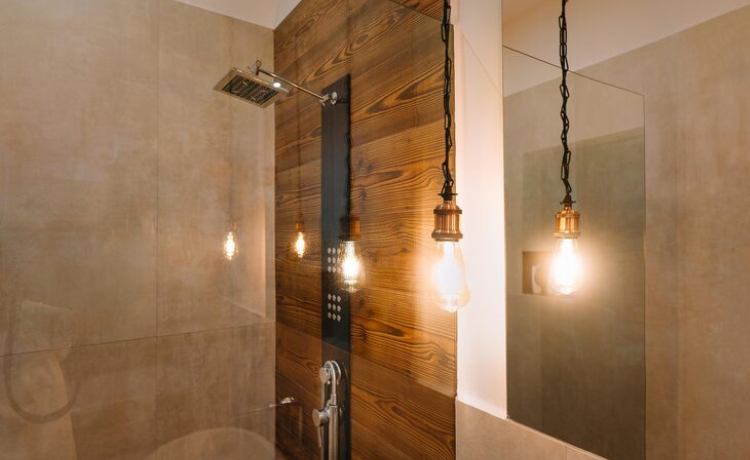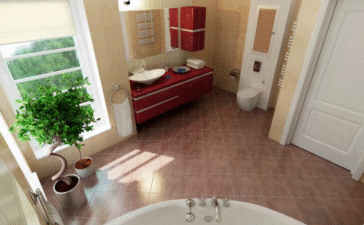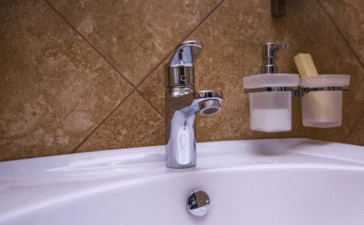The bathroom is no longer just a functional space; it has become a personal sanctuary. As interior design evolves, so does our approach to every detail within our homes, including lighting. Bathroom pendant lighting is stepping into the spotlight, offering a perfect blend of style and practicality that traditional fixtures often miss. These hanging lights can transform a simple bathroom into a sophisticated retreat.
This guide will walk you through everything you need to know about choosing and installing bathroom pendant lighting. We’ll explore why these modern lighting solutions are gaining popularity, the different styles available, and where to place them for maximum impact. By the end, you’ll have the confidence to select the perfect pendant lights to illuminate your bathroom and reflect your personal style.
What is Bathroom Pendant Lighting?
Pendant lighting refers to any light fixture that hangs from the ceiling, suspended by a cord, chain, or rod. When used in a bathroom, these fixtures serve as both a source of light and a striking design element. Unlike flush-mount lights that sit flat against the ceiling, pendants hang down, drawing the eye and adding a layer of visual interest to the room. The importance of bathroom pendant lighting in modern design cannot be overstated. It offers a unique opportunity to introduce personality, whether you’re aiming for a sleek, contemporary look or a cozy, rustic vibe.
Why Choose Bathroom Pendant Lighting?
Choosing pendant lighting for bathrooms brings a host of benefits that go beyond simple illumination. These fixtures are instrumental in elevating your bathroom décor. A well-chosen pendant can act as a centerpiece, much like a piece of art, adding a touch of elegance or drama to the space. They are available in countless designs, materials, and colors, making it easy to find a style that complements your existing theme.
From a functional standpoint, pendant lights are incredibly versatile. They provide focused task lighting, which is essential for grooming routines like applying makeup or shaving. When placed strategically, such as over a vanity, they eliminate shadows that overhead lighting can create. Additionally, with the use of dimmers, they can provide soft, ambient light, creating a spa-like atmosphere perfect for a relaxing bath. The functional advantages of pendant lights make them a smart choice for any modern bathroom.
Types of Bathroom Pendant Lights
The variety of pendant light designs means there is a perfect match for any aesthetic.
Modern and Minimalist Designs
Minimalist pendant lights are defined by their sleek lines, simple forms, and often neutral tones. Fixtures made of materials like brushed metal, matte black, or simple glass globes fit perfectly into contemporary bathrooms. They offer understated elegance without overwhelming the space, providing clean and effective illumination.
Vintage and Industrial Styles
For a more character-rich look, vintage and industrial bathroom lighting is an excellent choice. These styles often feature materials like aged brass, wrought iron, and reclaimed wood. Exposed Edison bulbs are a hallmark of this trend, casting a warm, inviting glow that adds a nostalgic or rustic charm.
Nature-Inspired and Boho Pendants
If you want to create a serene and organic atmosphere, look to boho lighting ideas. Nature-inspired pendants made from materials like rattan, bamboo, or woven fabrics bring texture and warmth into the bathroom. These fixtures diffuse light beautifully, creating a soft and cozy feel that transforms your bathroom into a tranquil escape.
Where to Install Bathroom Pendant Lights
Strategic pendant light placement is crucial for achieving both functional and aesthetic goals.
Above Bathroom Vanities
One of the most popular placements is above the bathroom vanity. Hanging one or two pendants on either side of the mirror provides excellent task lighting for the sink area. This setup ensures even, shadow-free light on your face. For a single-sink vanity, a single larger pendant or a cluster of smaller ones can make a bold statement.
Over Bathtubs
Placing a pendant light above a freestanding tub can add a dramatic touch of sophistication. This creates a stunning focal point and provides soft mood lighting for a relaxing soak. However, safety is paramount. It’s essential to use a damp- or wet-rated fixture and follow strict electrical codes regarding placement over a water source.
Central Ceiling Installations
For general illumination, a larger pendant or a chandelier-style fixture can be installed in the center of the bathroom ceiling. This approach works best in larger bathrooms, providing broad, ambient light for the entire room. It serves as a decorative centerpiece while ensuring the space is well-lit.
Creating the Right Ambiance with Pendant Lighting
The right bathroom ambiance is achieved through careful consideration of lighting effects. The material of your pendant light shade plays a significant role in the glow and shadow play within the room. For example, a clear glass pendant will provide bright, direct light, while a fabric or frosted glass shade will diffuse the light for a softer, more ambient glow. Opaque metal shades will direct light downward, creating focused pools of light and dramatic shadows.
Matching your pendant light finishes with your bathroom’s color scheme is also important. For a modern, monochrome design, a matte black or chrome pendant works well. In a bathroom with warmer tones, finishes like brass, copper, or gold can add a touch of luxury. The color temperature of the bulb also impacts the mood; warm white light (2700-3000K) creates a cozy, relaxing atmosphere, while cool white light (3500-4500K) is better for task-oriented areas.
Choosing the Right Materials and Finishes
Selecting the right materials for your bathroom pendant lights is critical for both longevity and style.
Glass, Metal, and Fabric Fixtures
Glass pendant lights are a popular choice because they are easy to clean and fit well with various design styles. Metal bathroom lighting, with finishes like chrome, nickel, or brass, offers durability and a sleek, modern look. Fabric shades can add softness and texture, but they may not be suitable for high-moisture areas unless specifically treated.
Moisture-Resistant and Durable Materials
The bathroom is a high-moisture environment, so it’s vital to choose moisture-resistant fixtures. Look for materials that won’t rust, corrode, or warp over time. Stainless steel, powder-coated metals, and high-quality glass are excellent choices. Always check the fixture’s IP (Ingress Protection) rating to ensure it is suitable for damp or wet locations.
Energy Efficiency and Smart Bathroom Pendant Lighting
Modern lighting solutions offer more than just style; they also bring efficiency and convenience.
LED Pendant Lights
LED bathroom pendant lights are the go-to for energy-efficient bathroom lighting. LEDs consume significantly less energy than traditional incandescent bulbs and have a much longer lifespan, which means lower electricity bills and fewer bulb changes. They are also available in a wide range of color temperatures and brightness levels.
Smart Pendant Lighting Systems
Integrating smart pendant lighting allows you to customize your bathroom’s atmosphere with ease. Smart lighting systems can be controlled via a smartphone app or voice commands, allowing you to adjust brightness and even color temperature. You can create different lighting scenes, such as a bright, energizing setting for the morning and a dim, warm one for evening relaxation.
Safety Considerations for Bathroom Pendant Lighting
Safety should always be a top priority when installing any electrical fixture in the bathroom.
Moisture-Rated Fixtures
Ensure any pendant light you choose is rated for use in a bathroom. Lighting fixtures are rated as suitable for dry, damp, or wet locations. A fixture rated for damp locations is suitable for most bathroom areas, but a wet-rated fixture is required for inside a shower or directly over a tub where it might be exposed to direct water spray.
Proper Hanging Height and Placement
Follow guidelines for pendant light height to ensure they provide adequate light without being an obstruction. Over a vanity, the bottom of the pendant should hang about 30-36 inches above the countertop. When placed over a bathtub, it must be at least 8 feet above the tub’s rim and 3 feet away horizontally to comply with safety codes.
Popular Bathroom Pendant Lighting Trends
Staying current with bathroom lighting trends can help you create a modern and stylish space. For 2025, we’re seeing a move toward sustainable lighting, with fixtures made from recycled or natural materials. Smart home lighting integration continues to be a major trend, offering convenience and customization. Bold, sculptural pendants that act as statement pieces are also gaining popularity, alongside minimalist designs that focus on clean lines and functionality.
How to Install Bathroom Pendant Lights
When it comes to installation, you must decide between a DIY approach and hiring a professional.
DIY vs. Professional Installation
If you have experience with electrical wiring, installing a pendant light can be a manageable DIY project. However, due to the combination of electricity and water, it’s often best to hire a licensed electrician. A professional will ensure the installation is up to code and completely safe, which is especially important for fixtures placed near water sources.
Step-by-Step Guide to Installing Pendant Lights
If you choose the DIY route, always turn off the power at the circuit breaker first. Your basic steps will involve removing the old fixture, installing the new mounting bracket, connecting the wires (hot, neutral, and ground), securing the new fixture, and finally, installing the bulb and shade. Always follow the manufacturer’s instructions for your specific pendant light.
Also Check: “light fitting bathroom ceiling“
Final Thoughts on Your Lighting Choice
Bathroom pendant lighting offers a fantastic way to blend style, functionality, and ambiance. By choosing the right design, material, and placement, you can elevate your bathroom from a purely utilitarian room to a personal haven. Remember to prioritize safety by selecting moisture-rated fixtures and ensuring proper installation. With the vast array of pendant light styles available, you can find the perfect lighting solution to reflect your taste and enhance your daily routines.
Frequently Asked Questions
Can pendant lights be used in a small bathroom?
Yes, pendant lights can work wonderfully in a small bathroom. Opt for smaller, more delicate pendants or a single, slim-profile fixture to avoid overwhelming the space. Placing them on either side of the vanity mirror can create an illusion of more space and provide excellent task lighting without cluttering the countertop.
Are pendant lights safe for use above bathtubs?
Pendant lights can be safe above bathtubs if you follow strict safety regulations. The fixture must be wet-rated, meaning it is designed to withstand direct contact with water. Additionally, electrical codes require that the bottom of the fixture must be at least 8 feet above the highest point of the tub’s edge. It is highly recommended to have a professional electrician handle this type of installation.
How do I clean and maintain bathroom pendant lights?
Maintenance depends on the material. Glass pendants, use a glass cleaner and a soft cloth. For metal fixtures, a dry microfiber cloth is usually sufficient to remove dust; for tougher spots, a damp cloth can be used, but ensure the fixture is dried afterward to prevent water spots or damage. For fabric shades, use a duster or a vacuum with a brush attachment. Always turn the light off and wait for the bulb to cool before cleaning.











